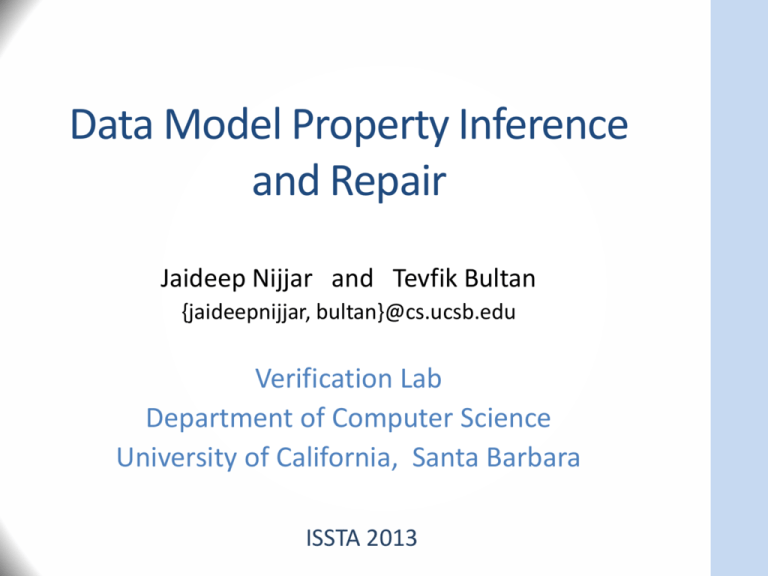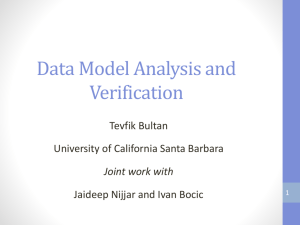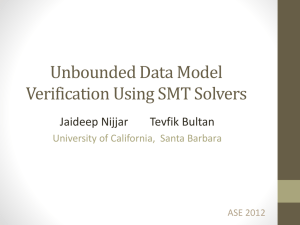power point presentation - UCSB Computer Science
advertisement

Data Model Property Inference
and Repair
Jaideep Nijjar and Tevfik Bultan
{jaideepnijjar, bultan}@cs.ucsb.edu
Verification Lab
Department of Computer Science
University of California, Santa Barbara
ISSTA 2013
Motivation
• Web applications influence every aspect of our lives
• Our dependence on web applications keep increasing
• It would be nice if we can improve the dependability of
web applications
Acknowledgement: NSF Support
HTTP Status 500 type Exception report
message
description The server encountered an internal error () that prevented it from fulfilling this request.
exception
javax.servlet.ServletException: flp.fl_appl_stts not found. Specify owner.objectname or use sp_help to check whether the object e
org.apache.jasper.runtime.PageContextImpl.doHandlePageException(PageContextImpl.java:830)
org.apache.jasper.runtime.PageContextImpl.handlePageException(PageContextImpl.java:763)
org.apache.jsp.fastlane_jsp._jspService(fastlane_jsp.java:242)
org.apache.jasper.runtime.HttpJspBase.service(HttpJspBase.java:105)
javax.servlet.http.HttpServlet.service(HttpServlet.java:860)
org.apache.jasper.servlet.JspServletWrapper.service(JspServletWrapper.java:336)
org.apache.jasper.servlet.JspServlet.serviceJspFile(JspServlet.java:302)
org.apache.jasper.servlet.JspServlet.service(JspServlet.java:251)
javax.servlet.http.HttpServlet.service(HttpServlet.java:860)
org.apache.jasper.runtime.PageContextImpl.doForward(PageContextImpl.java:675)
org.apache.jasper.runtime.PageContextImpl.forward(PageContextImpl.java:642)
org.apache.jsp.index_jsp._jspService(index_jsp.java:44)
org.apache.jasper.runtime.HttpJspBase.service(HttpJspBase.java:105)
javax.servlet.http.HttpServlet.service(HttpServlet.java:860)
org.apache.jasper.servlet.JspServletWrapper.service(JspServletWrapper.java:336)
org.apache.jasper.servlet.JspServlet.serviceJspFile(JspServlet.java:302)
org.apache.jasper.servlet.JspServlet.service(JspServlet.java:251)
javax.servlet.http.HttpServlet.service(HttpServlet.java:860)
root cause
java.sql.SQLException: flp.fl_appl_stts not found. Specify owner.objectname or use sp_help to check whether the object exists (sp
gov.nsf.fastlane.util.ApplicationStatus.<init>(ApplicationStatus.java:95)
org.apache.jsp.fastlane_jsp._jspService(fastlane_jsp.java:79)
org.apache.jasper.runtime.HttpJspBase.service(HttpJspBase.java:105)
javax.servlet.http.HttpServlet.service(HttpServlet.java:860)
org.apache.jasper.servlet.JspServletWrapper.service(JspServletWrapper.java:336)
org.apache.jasper.servlet.JspServlet.serviceJspFile(JspServlet.java:302)
Three-Tier Architecture
Browser
Web Server
Backend
Database
Three-Tier Arch. + MVC Pattern
Browser
Web
Server
Controller
Model
Backend
Database
Views
Model-View-Controller Pattern
DB
Model
• MVC has become
the standard way
to structure web
applications
•
•
•
•
•
•
Ruby on Rails
Zend for PHP
CakePHP
Struts for Java
Django for Python
…
View
• Benefits of the
MVC pattern:
Controller
UserResponse
Request
User
• Separation of
concerns
• Modularity
• Abstraction
Data Model
• Data model is the heart of the web application
• It specifies the set of objects and the associations (i.e.,
relations) between them
• Using an Object-Relational-Mapping the data model is
mapped to the back-end datastore
• Any error in the data model can have serious consequences
for the dependability of the application
Our Data Model Analysis Approach
Active
Records
Data Model
(Schema +
Constraints)
Model
Extraction
Data Model +
Inferred Properties
Property
Inference
Data Model
Schema
Orphan
Prevention
Failing
Properties
Verification
Inferred
Properties
Transitive
Relations
Delete
Propagation
Repair
Generation
Outline
• Motivation
• Overview of Our Approach
• Rails Data Models
• Basic Relations
• Options to Extend Relations
• Formalization of Semantics
•
•
•
•
•
Verification Techniques
Property Inference
Property Repair
Experiments
Conclusions and Future Work
A Rails Data Model Example
class User < ActiveRecord::Base
has_and_belongs_to_many :roles
has_one :profile, :dependent => :destroy
has_many :photos, :through => :profile
end
class Role < ActiveRecord::Base
has_and_belongs_to_many :users
end
class Profile < ActiveRecord::Base
belongs_to :user
has_many :photos, :dependent => :destroy
has_many :videos, :dependent => :destroy,
:conditions => "format='mp4'"
end
class Tag < ActiveRecord::Base
belongs_to :taggable, :polymorphic => true
end
class Video < ActiveRecord::Base
belongs_to :profile
has_many :tags, :as => :taggable
end
class Photo < ActiveRecord::Base
...
Role
*
*
1
User
1
*
0..1
Photo
1
Taggable
*
Tag
*
1
Profile
1
format=.‘mp4’
1
*
Video
Rails Data Models
• Data model analysis verification: Analyzing the relations
between the data objects
• Specified in Rails using association declarations inside the
ActiveRecord files
• Three basic relations
• One-to-one
• One-to-many
• Many-to-many
• Extensions to the basic relationships using Options
• :through, :conditions, :polymorphic, :dependent
Three Basic Relations in Rails
• One-to-One
class User < ActiveRecord::Base
has_one :profile
end
User
1
.
class Profile < ActiveRecord::Base
belongs_to :user
end
0..1
Profile
.
• One-to-Many
class Profile < ActiveRecord::Base
has_many :videos
end
Profile
1
.
class Video < ActiveRecord::Base
belongs_to :profile
end
*
Video
Three Basic Relations in Rails
• Many-to-Many
class User < ActiveRecord::Base
has_and_belongs_to_many :users
end
class Role < ActiveRecord::Base
has_and_belongs_to_many :roles
end
User
*
*
Role
Extensions to the Basic Relations
• :through Option
• To express transitive relations
• :conditions Option
• To relate a subset of objects to another class
• :polymorphic Option
• To express polymorphic relationships
• :dependent Option
• On delete, this option expresses whether to delete the associated
objects or not
The :through Option
class User < ActiveRecord::Base
has_one :profile
has_many :photos, :through => :profile
end
class Profile < ActiveRecord::Base
belongs_to :user
has_many :photos
end
class Photo < ActiveRecord::Base
belongs_to :profile
end
Profile
0..1
1
*
1
User
1
*
Photo
The :dependent Option
class User < ActiveRecord::Base
has_one :profile, :dependent => :destroy
end
class Profile < ActiveRecord::Base
belongs_to :user
has_many :photos, :dependent => :destroy
end
User
1
0..1
Profile
1
*
Photo
• :delete directly delete the associated objects without looking
at its dependencies
• :destroy first checks whether the associated objects
themselves have associations with the :dependent option set
and recursively propagates the delete to the associated objects
Formalizing Data Model Semantics
Formal data model: M = <S, C, D>
• S: Data model schema
• The sets and relations of the data model, e.g., { Photo, Profile, Role, Tag,
Video, User} and the relations between them
• C: Constraints on the relations
• Cardinality constraints, transitive relations, conditional relations,
polymorphic relations
• D: Dependency constraints about deletions
• Express conditions on two consecutive instances of a relation such
that deletion of an object from the first instance leads to the other
instance
Outline
•
•
•
•
Motivation
Overview of Our Approach
Rails Data Models
Verification Techniques
• Bounded Verification
• Unbounded Verification
•
•
•
•
Property Inference
Property Repair
Experiments
Conclusions and Future Work
Verification Overview
Active Records
Model
Extraction
Bound
bound
Properties
Data model +
properties
BOUNDED VERIFICATION
formula
UNBOUNDED VERIFICATION
Alloy
Translator
SMT-LIB
Translator
formula
Alloy
Analyzer
SMT
Solver
instance
or unsat
Results
Results
Interpreter
Interpreter
Property
Verified
Property Failed +
Counterexample
instance
or unsat
or unknown
Unknown
Sample Translation to Alloy
class User < ActiveRecord::Base
has_one :profile
end
class Profile < ActiveRecord::Base
belongs_to :user
end
sig Profile {}
sig User {}
one sig State {
profiles: set Profile,
users: set User,
relation: Profile lone -> one User
}
Sample Translation to SMT-LIB
class User < ActiveRecord::Base
has_one :profile
end
class Profile < ActiveRecord::Base
belongs_to :user
end
(declare-sort User)
(declare-sort Profile)
(declare-fun relation (Profile) User)
(assert (forall ((p1 Profile)(p2 Profile))
(=> (not (= p1 p2))
(not (= (relation p1) (relation p2) ))
)
))
Property Inference: Motivation
• Verification techniques require properties as input
• Effectiveness depends on quality of properties written
• Manually writing properties is time-consuming,
error-prone, lacks thoroughness
• Requires familiarity with the modeling language
• We propose techniques for automatically inferring properties
about the data model of a web application
• Inference is based on the data model schema
• A directed, annotated graph that represents the relations
Data Model Schema Example
Outline
•
•
•
•
•
Motivation
Overview of Our Approach
Rails Data Models
Verification Techniques
Property Inference
• Orphan Prevention Pattern
• Transitive Relation Pattern
• Delete Propagation Pattern
• Property Repair
• Experiments
• Conclusions and Future Work
Property Inference: Overview
• Identify patterns in the data model schema graph that
indicates that certain property should hold in the data model
• Extract the data model schema from the ActiveRecords
declarations
• Search for the identified patterns in the data model schema
graph
• If a match is found, report the corresponding property
Orphan Prevention Pattern
...
• For objects of a class that has only one relation: when the
object it is related to is deleted but the object itself is not,
such an object becomes orphaned
• Orphan chains can also occur
• Heuristic looks at all one-to-many or one-to-one relations to
identify all potential orphans or orphan chains
• Infers that deleting an object does not create orphans
0
1
...
n
Transitive Relation Pattern
• Looks at one-to-one or one-to-many relations in schema
• Finds paths of relations that are of length > 1
• If there is a direct edge between the first and last node of the
path, infer that this edge should be transitive, i.e. the
composition of the others
1
2
...
n
Delete Propagation Pattern
• Look at schema with all relations removed that are many-tomany or transitive
• Remove cycles in graph by collapsing strongly connected
components to a single node
• Assign levels to all nodes indicating its depth in the graph
• Root node(s), those with no incoming edges, are at level 0
• Remaining nodes are at level 1 more than the maximum of their
predecessors
• Propagate deletes if levels between nodes is one
1
1
level=0
2
3
4
2
level=1
c
level=2
Repair Generation
• Check the inferred properties on the formal data model
• If a property fails we can point out the option that needs to be
set in the data model to make sure that the inferred property
holds
• For delete propagates and orphan prevention patterns: Set
the dependency option accordingly to propagate the deletes
• For transitive property: Set the through option accordingly to
make a relation composition of two other relations
Repair Examples
1
2
3
4
5
6
7
8
9
10
11
12
13
14
15
16
17
18
19
20
21
class User < ActiveRecord::Base
has_one :preference, :conditions => "is_active=true”,
:dependent => :destroy
has_many :contexts, :dependent => :destroy
has_many :todos, :through => :contexts
end
class Preference < ActiveRecord::Base
belongs_to :user
end
class Context < ActiveRecord::Base
belongs_to :user
has_many :todos, :dependent => :delete
end
class Todo < ActiveRecord::Base
belongs_to :context
# belongs_to: user
has_and_belongs_to_many :tags
end
class Tag < ActiveRecord::Base
has_and_belongs_to_many :todos
end
Outline
•
•
•
•
•
•
•
•
Motivation
Overview of Our Approach
Rails Data Models
Verification Techniques
Property Inference
Property Repair
Experiments
Conclusions and Future Work
Experiments on Five Applications
Application
LOC
Classes
Data Model
Classes
LovdByLess
3787
61
13
Substruct
15639
85
17
Tracks
6062
44
13
FatFreeCRM
12069
54
20
OSR
4295
41
15
A Social Networking Application
•
•
•
•
LovdByLess: A social networking application
Users can write blog entries
Users can comment on a friend’s blog entry
Friend deletes blog entry
A Social Networking Application
• A friend writes a blog entry
• User comments on the friend’s blog entry
• Friend deletes the blog entry
A Failing Inferred Property
• deletePropagates property inferred for LovdByLess
Blog
delete should propagate
Comment
A Todo List Application
•
•
•
•
Tracks: A todo list application
Todos can be organized by Contexts
Users can also create Recurring Todos
Delete the Context. Then edit the Recurring Todo.
A Failing Inferred Property
• Data Model and Application Error: deletePropagates
property inferred for Tracks
Context
delete should propagate
RecurringTodo
False Positives
• deletePropagates property inferred for FatFreeCRM
Account
delete should propagate
Contact
• But in FatFreeCRM it is valid to have a contact not associated
with any account
False Positives
• transitive property inferred for LovdByLess
ForumTopic
User
ForumPost
• Just not a transitive relation due to semantics of the
application
Experiment Results
Application
LovdByLess
Substruct
Tracks
FatFreeCRM
OSR
Property Type
# Inferred
# Timeout
# Failed
deletePropagates
13
0
10
noOrphans
0
0
0
transitive
1
0
1
deletePropagates
27
0
16
noOrphans
2
0
1
transitive
4
0
4
deletePropagates
15
0
6
noOrphans
1
0
1
transitive
12
0
12
deletePropagates
32
1
19
noOrphans
5
0
0
transitive
6
2
6
deletePropagates
19
0
12
noOrphans
1
0
1
transitive
7
0
7
# Data Model
& Application
Errors
# Data Model
Errors
# Failures Due
to Rails
Limitations
# False
Positives
deletePropagates
1
9
0
0
noOrphans
0
0
0
0
transitive
0
0
0
1
deletePropagates
1
3
5
7
noOrphans
0
1
0
0
transitive
0
1
0
3
deletePropagates
1
1
3
1
noOrphans
0
0
0
5
transitive
0
7
0
5
deletePropagates
0
18
1
0
noOrphans
0
0
0
0
transitive
0
0
0
6
deletePropagates
0
12
0
0
noOrphans
0
1
0
0
transitive
0
7
0
0
Property Type
Conclusions and Future Work
• It is possible to extract formal specifications from MVC-based
data models and analyze them
• We can automatically infer properties and find errors in realworld web applications
• Most of the errors come from the fact that developers are not
using the ActiveRecords extensions properly
• This breaks the modularity, separation of concerns and
abstraction principles provided by the MVC pattern
• We are working on analyzing actions that update the data
store
• We are also investigating verifiable-model-driven
development for data models
Related Work
• Automated Discovery of Likely Program Invariants
• Daikon [Ernst et al, ICSE 1999] discovers likely invariants by
observing the runtime behaviors of a program
• [Guo et al, ISSTA 2006] extends this style of analysis and applies it
to the inference of abstract data types
• We analyze the static structure of an extracted data model to
infer properties
• Static Verification of Inferred Properties
• [Nimmer and Ernst, 2001] integrate Daikon with ESC/Java, a static
verification tool for Java programs
• We focus on data model verification in web applications
Related Work
• Verification of Web Applications
• [Krishnamurti et al, Springer 2006 ] focuses on correct handling of
the control flow given the unique characteristics of web apps
• Works such as [Hallé et al, ASE 2010] and [Han et al, MoDELS
2007] use state machines to formally model navigation behavior
• In contrast to these works, we focus on analyzing the data model
• Formal Modeling of Web Applications
• WebAlloy [Chang, 2009]: user specifies the data model and
access control policies; implementation automatically synthesized
• WebML [Ceri et al, Computer Networks 2000]: a modeling
language developed specifically for modeling web applications;
no verification
• In contrast, we perform model extraction (reverse engineering)
Related Work
• Verification of Ruby on Rails applications
• Rubicon [Near et al, FSE 2012] verifies the Controller whereas we
verify the Data Model
• Requires manual specification of application behavior, whereas
we verify manually written properties
• Limited to bounded verification
• Data Model Verification using Alloy
• [Cunha and Pacheco, SEFM 2009] maps relational database
schemas to Alloy; not automated
• [Wang et al, ASWEC 2006] translates ORA-SS specifications to
Alloy, and uses the Analyzer to produces instances of the data
model to show consistency
• [Borbar et al, Trends 2005] uses Alloy to discover bugs in browser
and business logic interactions
Related Work
• Unbounded Verification of Alloy Specifications using SMT
Solvers
• [Ghazi et al, FM 2011], approach not implemented
• More challenging domain since Alloy language contains
constructs such as transitive closures
• Specification and Analysis of Conceptual Data Models
• [Smaragdakis et al ASE 2009, McGill et al ISSTA 2011] use
Object Role Modeling to express data model and constraints
• Focus is on checking consistency and producing test cases
efficiently
Questions?





